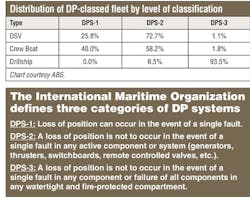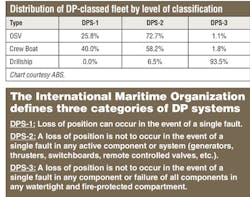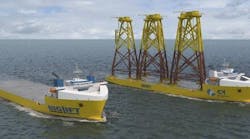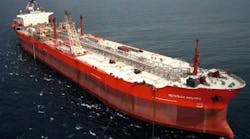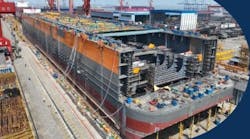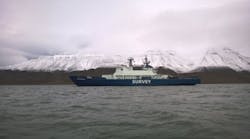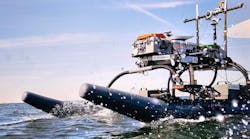Wei Huang
Sue Wang
ABS
Increasing numbers of offshore floating structures are now equipped with dynamic positioning (DP) for station keeping, and these DP technologies are being applied in a growing range of applications. With more systems working in more exacting environments, it is more important than ever to make sure systems are reliable.
In February 2015, the US Coast Guard (USCG) and the Bureau of Safety and Environmental Enforcement issued a Joint Safety Alert addressing DP systems. The impetus for the release was an incident that involved an offshore support vessel working on the US outer continental shelf (OCS). The alert includes details about the specific event, but the bigger message is that there is room for improvement in DP safety.
Past and present
DP systems have been used on offshore floating structures for decades, and have expanded and evolved as offshore activities moved into deeper water. The most advanced systems now feature improved station keeping, robust redundancy design concepts, and rapid automatic blackout recovery.
DP systems are safety-critical because they are used for station keeping during operations including those involving hazardous cargo, personnel transfers, underwater operations, drilling, and production. While DP systems have proven to be reliable and safe, they are susceptible to failure, and a DP incident that results in a loss of position could lead to serious consequences for human safety and the environment.
DP safety initiatives
ABS and other class societies look at DP systems in terms of how best to verify designs, carry out surveys during construction, and make sure periodic surveys after construction are able to verify the systems are working as required. In fact, there are many organizations working on various facets of DP system safety.
The International Maritime Organization's (IMO) IMO MSC/Circ. 645, "Guidelines for Vessels with Dynamic Positioning Systems," has been the widely accepted baseline standard for DP safety since its publication in 1994. The USCG-led group submitted a proposal to IMO to revise the guidelines to reflect advances in technology and to update guidance on operations. The proposal also explores the use of the Flag State Verification and Acceptance Document.
Meanwhile, the USCG is in the process of rulemaking for DP systems. The USCG proposes to establish minimum design, operation, training, and manning standards for mobile offshore drilling units and other vessels using DP systems on the OCS. Four levels of DP operations requirements are proposed in terms of types of operation and vessel size. The proposal also includes creation of a DP Systems Assurance Organization, an independent third party that would take on regulatory responsibilities in DP incident reporting and record keeping, perform DP plan reviews, conduct DP surveys and issue a DP verification acceptance document for each unit with DP. Initiatives like this are not being pursued in isolation. Multiple efforts are under way, including work by the International Marine Contractors Association, and Marine Technology Society.
Research findings
The ABS Guide for Dynamic Positioning Systems addresses current requirements and provides optional notations, including technical specifications that reflect current industry practice and DP technologies. The guide, which is applicable to systems installed onboard vessels, offshore installations and facilities, documents requirements for the design, testing, and surveying of DP systems.
The new enhanced system (EHS) notation encourages robust DP system design by providing optional requirements. The multiple levels of EHS notation - for power, control, and fire protection - provide the flexibility to tailor the notation to the most important system components for the unit's intended operations. The guide also offers an optional notation for station-keeping performance, which allows equipment selection based on North Sea conditions or environmental criteria specific to the intended area of operation. It also includes detailed procedures for assessing available thrust, taking into account thruster interactions, which is especially useful in the early stages of design.
ABS is working to improve DP safety through a research project that is evaluating the ability of advanced computing technologies to play an important role in the planning of DP vessel operations.
Historically, DP system station-keeping capability has been analyzed using a quasi-static approach, but ABS engineers have suggested the time domain simulation method can provide more detail on vessel performance. Research has shown this method provides more accurate predictions because it can include the transient responses of the control system, thruster systems, load effects, and the vessel's motions. It also can provide the vessel's performance for a given sea condition in terms of thrust/power and the vessel's offsets from its desired position.
This insight into the system and the vessel's performance can aid operational planning and onboard decision-making.
Projects targeting DP safety cover a range of industry stakeholders and subjects, but they all have the same goal: preventing a DP incident resulting in a loss of position that could lead to serious consequences for human safety and the environment. •
